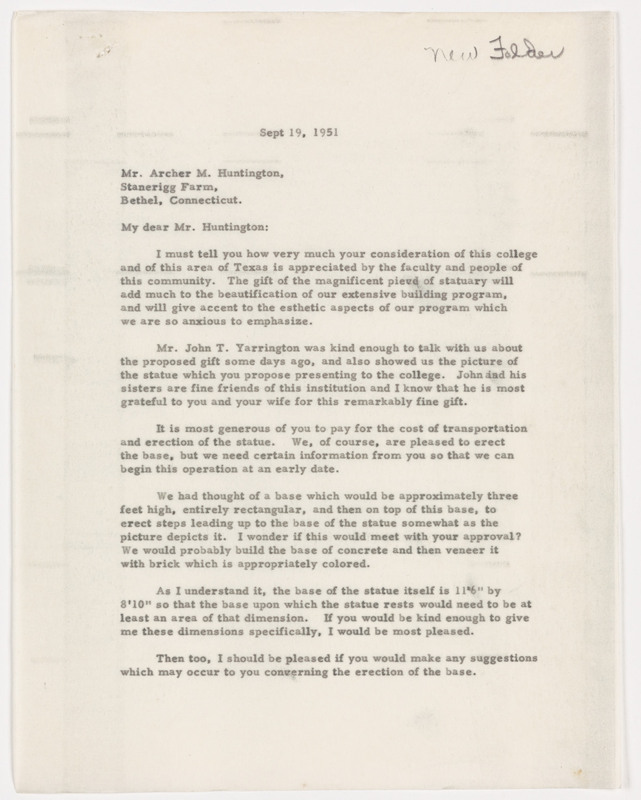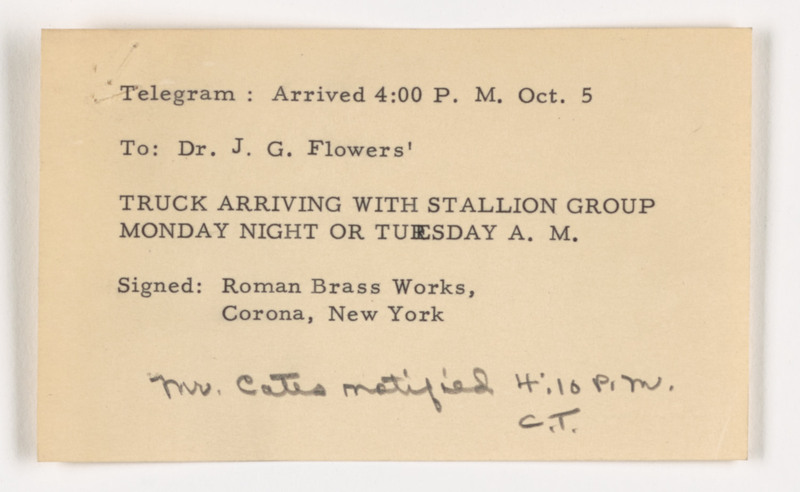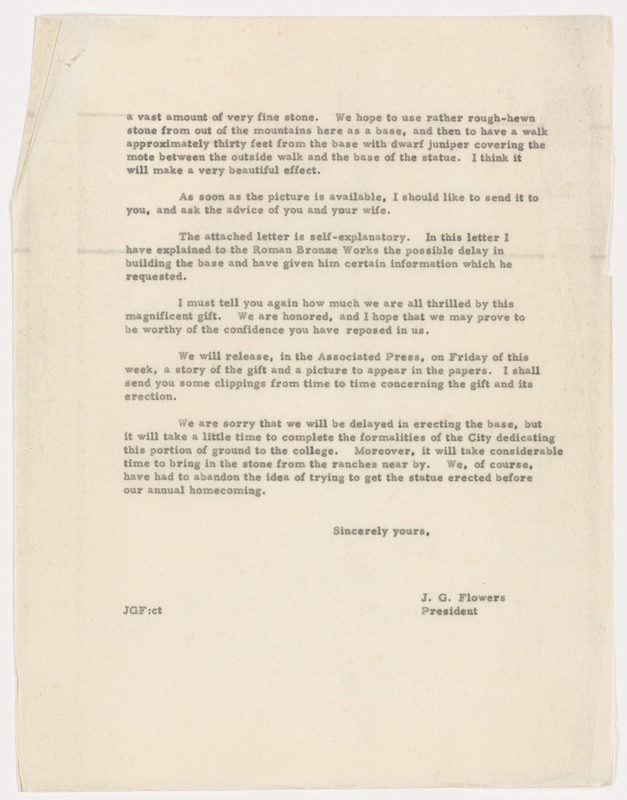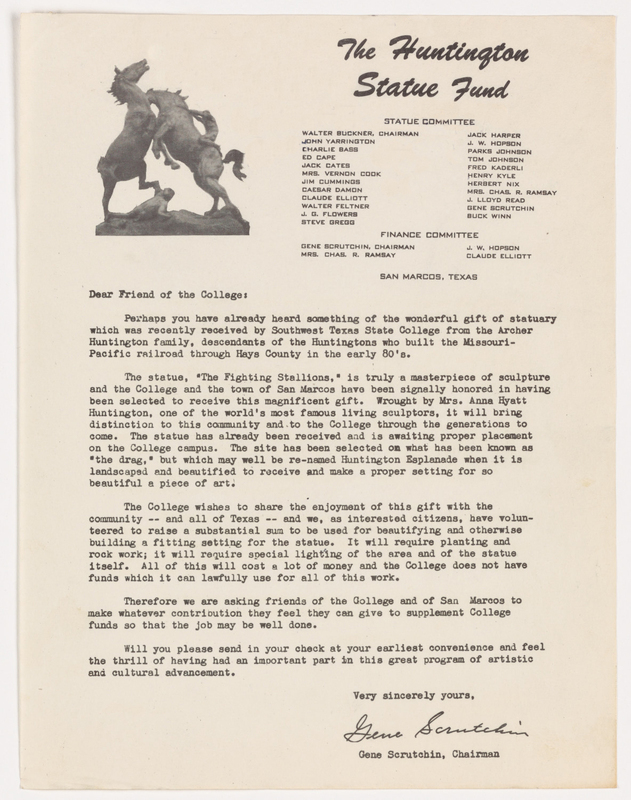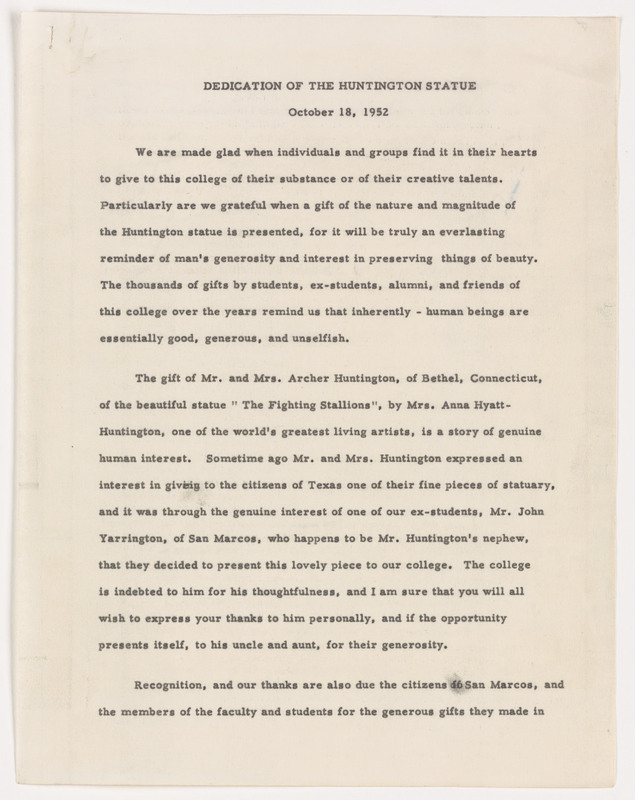Stallions Correspondence
This page contains images and transcriptions of the letters that were selected and featured in this exhibition. The Fighting Stallions statue collection is part of the University Archives at Texas State University; the collection is digitized and available for research.
September 19, 1951
Mr. Archer M. Huntington,
Stanerigg Farm,
Bethel, Connecticut.My dear Mr. Huntington:
I must tell you how very much your consideration of this college and of this area of Texas is appreciated by the faculty and people of this community. The gift of the magnificent piece of statuary will add much to the beautification of our extensive building program, and will give accent to the esthetic aspects of our program which we are so anxious to emphasize.
Mr. John T. Yarrington was kind enough to talk with us about the proposed gift some days ago, and also showed us the picture of the statue which you propose presenting to the college. John and his sisters are fine friends of this institution and I know that he is most grateful to you and your wife for this remarkably fine gift.
It is most generous of you to pay for the cost of transportation and erection of the statue. We, of course, are pleased to erect the base, but we need certain information from you so that we can begin this operation at an early date.
We had thought of a base which would be approximately three feet high, entirely rectangular, and then on top of this base, to erect steps leading up to the base of the statue somewhat as the picture depicts it. I wonder if this would meet with your approval? We would probably build the base of concrete and then veneer it with brick which is appropriately colored.
As I understand it, the base of the statue itself is 11' 6" by 8' 10" so that the base upon which the statue rests would need to be at lease an area of that dimension. If you would be kind enough to give me these dimensions specifically, I would be most pleased.
Then too, I should be pleased if you would make any suggestions which may occur to you concerning the erection of the base.
[page 2]
It happens that on November 10 this college is celebrating its Fiftieth Anniversary. We will have many thousands of people here from all over the state and various parts of the nation. The Governor and United States Senator Johnson from Texas, who was a former student of this college, will be speakers on the program. I do not know whether it would be convenient for you to ship the statue in time for it to be erected by that time, but it would be an excellent opportunity to give the widest publicity to the gift and at the same time afford enjoyment to many thousands of ex-students and friends of the college.
Again I thank you for your thoughtfulness and generosity.
Sincerely yours,
J.G. Flowers
President
Telegram: Arrived 4:00 P.M. Oct. 5
To: Dr. J.G. Flowers'
TRUCK ARRIVING WITH STALLION GROUP
MONDAY NIGHT OR TUESDAY A.M.
Signed: Roman Brass Works, Corona New York
Handwritten note: Mr. Cates notified 4:10 P.M. C.T.
October 11, 1951
Mr. S. P. Schiavo,
Roman Bronze Works, Inc.,
96-18 43rd. Ave.,
Corona, N.Y.
Dear Mr. Schiavo:I am pleased to report to you that the aluminum casting of the "Fighting Stallions" has arrived in fine order. This is a magnificent piece of statuary for which we are very thankful to the Huntingtons.
Mr. Huntington has informed me that you would come down to assemble the group after the base has been erected, and I wish now to inform you of certain development which you will want to take into account. When we discovered that the statue of the magnitude that it is, we discovered at once that it would need to have a large area in which to be placed and that the base was of the first importance. I brought in as an advisor a leading artist of this part of the country, who is a sculptor of some note, and after discussing the matter with him as to location, we have made some certain decisions as follows:
- It will be two or three months before we will have the base erected. The artist who is assisting us insists upon a pedestal that will be at least nine and one-half feet high.
- You will be able to rent a crane and hoisting equipment to place the statue here. There are two or three possibilities open to you.
- It is possible for you to get oxygen or acetylene welding equipment as you choose.
- It is possible to get a compressor as near the sight [sic] as you choose.
- We will be glad to help with the scaffolding as you
[end of letter - there is no second page]
Mr. Archer M. Huntington,
Stanerigg Farm,
Bethel, Conn.Dear Mr. Huntington:
We are pleased to inform you that the statue arrived this week and that it was not damaged in the least. The driver of the truck apparently took good care of it and we have now placed it in storage awaiting the time when we can erect the base and have it mounted.
Several interesting developments have taken place in the community here since I last wrote to you. It so happens that when we discovered the size of the statue and that it would require considerable space, we felt that we should draw in an expert as a counsellor. We asked Mr. Winn, who is very well known in this part of the country as an artist, to come in and discuss the matter with us. After going over our campus carefully, we made three tentative locations. Our first choice was to pace it in almost the exact center of the campus and to reroute the drivers around it so that it could be enjoyed by as many people as possible. This entails several conferences with local people, especially the City Commission, and I brought together twenty leading citizens of the town to discuss the whole problem.
They became very much interested in the project with the result that we now plan a magnificent arrangement, which will display the statue at the intersection of two very busy streets. It will be so placed that it can be seen from quite a distance. The City and the community will share with us in building the base and arranging the proper lighting.
Just as soon as I can get a picture of the proposed base we plan to erect, I shall mail it to you. I have a drawing which is now being photographed that Mr. Winn has made an I believe you will think it is quite lovely. As you may know, near San Marcos there is
[page 2]
a vast amount of very fine stone. We hope to use rather rough-hewn stone from out of the mountains here as a base, and then to have a walk approximately thirty feet from the base with dwarf juniper covering the mote [sic?] between the outside walk and the base of the statue. I think it will make a very beautiful effect.
As soon as the picture is available, I should like to send it to you, and ask the advice of you and your wife.
The attached letter is self-explanatory. In this letter I have explained to the Roman Bronze Works that the possible delay in building the base and have given him certain information which he requested.
I must tell you again how much we are all thrilled by this magnificent gift. We are honored, and I hope that we may prove to be worth of the confidence you have reposed in us.
We will release, in the Associated Press, on Friday of this week, a story of the gift and a picture to appear in the papers. I shall send you some clippings from time to time concerning the gift and its erection.
We are sorry that we will be delayed in erecting the base, but it will take a little time to complete the formalities of the City dedicating this portion of the ground to the college. Moreover, it will take considerable time to bring in the stone from the ranches near by. We, of course, have had to abandon the idea of trying to get the statue erected before our annual homecoming.
Sincerely yours,
J.G. Flowers
President
The Huntington Statue Fund
Statue Committee:
Walter Buckner, Chairman
John Yarrington, Charlie Bass, Ed Cape, Mrs. Vernon Cook, Jim Cummings, Caesar Damon, Claude Elliott, Walter Feltner, J.G. Flowers, Steve Gregg, Jack Harper, J.W. Hopson, Parks Johnson, Tom Johnson, Fred Kaderli, Henry Kyle, Herbert Nix, Mrs. Chas. R. Ramsay, J.Lloyd Read, Gene Scrutchin, Buck Winn
Finance Committee:
Gene Scrutchin, Chairman
Mrs. Chas. R. Ramsay, J.W. Hopson, Claude Elliott
San Marcos, Texas
Dear Friend of the College:
Perhaps you have already heard something of the wonderful gift of statuary which was recently received by Southwest Texas State College from the Archer Huntington family, descendants of the Huntingtons who built the Missouri-Pacific railroad through Hays County in the early 80's.
The statue, "The Fighting Stallions," is truly a masterpiece of sculpture and the College and the town of San Marcos have been signally honored in having been selected to receive this magnificent gift. Wrought by Mrs. Anna Hyatt Huntington, one of the world's most famous living sculptors, it will bring distinction to this community and to the College through the generations to come. The statue has already been received and is awaiting proper placement on the College campus. The site has been selected on what has been known as "the drag," but which may well be re-named Huntington Esplanade when it is landscaped and beautified to receive and make a proper setting for so beautiful a piece of art.
The College wishes to share the enjoyment of this gift with the community -- and all of Texas -- and we, as interested citizens, have volunteered to raise a substantial sum to be used for beautifying and otherwise building a fitting setting for the statue. It will require planting and rock work; it will require special lighting of the area and of the statue itself. All of this will cost a lot of money and the College does not have funds which it can lawfully use for all of this work.
Therefore we are asking friends of the College and of San Marcos to make whatever contribution they feel they can give to supplement College funds so that the job may be well done.
Will you please send in your check at your earliest convenience and feel the thrill of having had an important part in this great program of artistic and cultural advancement.
Very sincerely yours,
Gene Scrutchin, Chairman
Wm. Cameron & Co.
Home of Complete Building Service
Ruben Balko, Mgr.
Telephone 547
Llano, Texas
January 17, 1952
Mr. J.G. Flowers,
Southwest Texas State Teachers College
San Marcos, Texas.
Dear Sir:
We have received your kind letter, and are happy to know that the granite stone from this fine old historical hotel which we have torn down in Llano, will be of further use to mankind.
Respectfully yours,
Ruben Balko
Note: The left side of the stationery includes small drawings with descriptions of services.
- Drawing of a driveway leading to a house. Text: Quality materials and complete service for construction, maintenance and decoration of the home.
- Drawing of a barn and fence. Text: Lumber, cement, fencing, roofing and building materials for every ranch and farm need.
- Drawing of an industrial building and large trucks. Text: Materials and supplies for industrial building and construction projects of any size. All types of roofs.
- Drawing of an oil derrick with tanks in the background. Text: Drilling clays, chemicals, timbers and building materials for oil field operations plus technical service.
Bottom of stationery reads: Trustworthy and Reliable Service Since 1868.
Mr. and Mrs. Archer M. Huntington,
Stanerigg Farm,
Bethel, Connecticut.
Dear Mr. and Mrs. Huntington:
The statue has been placed and we are now engaged in the process of landscaping the area around it. Mr. Schiavo was most complimentary to us of the manner in which we have placed the statue, and the utilization of native stone for the foundation. For the past week we have been bringing in native shrubs which we are planting around the base of the statue and in and around the large boulders which form the base, for plant material we are using cactus, agarita, cliff grass, yucca, and other forms of plant life native to this region.
Immediately surrounding the base is the children's playground of our Laboratory School, and since the statue is located in a slight depression, we are using native stone to build terraces surrounding the statue area. Eventually, as you look at the statue from two sides, you will see the same type of stone in the terraces that has been used in the base.
Under separate cover, I am mailing you a copy of the design for the Esplanade leading from the Main Building to the statue. We are developing the area so that this Esplanade will be a thing of beauty when it is finished. We shall have to move slowly as we have available funds, but I think you will agree with "the Fighting Stallions" at one of the Esplanade, and with some sort of decorative arrangement at the other end immediately in front of the Main Building, this will be truly an impressive area.
I wonder if it would give you pleasure to pay us a visit? You may be sure that we would be most happy to receive you on our campus. If it were possible for you to come this way for a visit, I should like to plan a simple dedicatory program. It would give us all great pleasure to thank you in person for this marvelous gift. I know, too, that your relative, John Yarrington, and his sisters would be most happy to see both of you.
[Page 2]
Any criticism you may wish to offer concerning plans will be most appreciated. Actually, I think the plans are more ornate than the finished product will be. It is my belief that we should achieve beauty through simplicity of line and color, and not in ornateness, although in this section of the country much use is made of the Spanish-American traditional use of color and material.
Within a few days, I expect to have some pictures made to send to you. We have waited until we were a little further advanced in our landscaping before we had the pictures made. In the meantime, I hope you may enjoy looking at the plans which are being developed under the supervision of Mr. Homer Fry, landscape architect.
Sincerely yours,
J.G. Flowers
President
My dear Dr. Flowers:
Your letter of April 2nd with the plans and outline for the statue has just come and we were delighted with it. I hope that you do not feel that we have increased your own personal burdens by unconsciously inducing changes which you might not find it convenient to maintain. Development of the Esplanade I am sure will be a triumph of beauty and will be one further charm to the setting of your buildings.
I wish that my rheumatism were not so bad, and were it not I can assure you that nothing would prevent our taking the trip to San Marcos and enjoying the development of the changes which you have been making. I shall look forward to the pictures of which you speak with pleasant anticipation.
With cordial regard believe me,
Yours sincerely,
Archer M. Huntington
Dedication of the Huntington Statue
October 18, 1952
We are made glad when individuals and groups find it in their hearts to give to this college of their substance or of their creative talents. Particularly are we grateful when a gift of the nature and magnitude of the Huntington statue is presented, for it will be truly an everlasting reminder of man's generosity and interest in preserving things of beauty. The thousands of gifts by students, ex-students, alumni, and friends of this college over the years remind us that inherently - human beings are essentially good, generous, and unselfish.
The gift of Mr. and Mrs. Archer Huntington, of Bethel, Connecticut, of the beautiful statue "The Fighting Stallions", by Mrs. Anna Hyatt-Huntington, one of the world's greatest living artists, is a story of genuine human interest. Sometime ago Mr. and Mrs. Huntington expressed an interest in giving to the citizens of Texas one of their fine pieces of statuary, and it was through the genuine interest of one of our ex-students, Mr. John Yarrington, of San Marcos, who happens to be Mr. Huntington's nephew [cousin], that they decided to present this lovely piece to our college. The college is indebted to him for his thoughtfulness, and I am sure that you will all wish to express your thanks to him personally, and if the opportunity presents itself, to his uncle and aunt [cousins Archer and Anna], for their generosity.
Recognition, and our thanks are also due the citizens of San Marcos, and the members of the faculty and students for the generous gifts they made in
[page 2]
making funds available for the erection of the base and for the plans now being developed for landscaping the area surrounding the statue and the Esplanade leading to the Main building. Special mention should be made of Mr. Buck Winn, of Wimberley, the artist, for his suggestions and help in planning the general location and layout for the statue, to Mr. Jim Cummings, of San Marcos, for his assistance in providing heavy equipment for moving the stones for the base, and to the Cameron Lumber Company, of Llano, for their gift of granite taken from an historic building of that city.
Lest we omit someone to whom our thanks should be expressed, we may again thank all who have in any way given of their time, their interest, or their money to this undertaking.
A few words concerning Mrs. Anna Hyatt-Huntington, the artist, are appropriate.
In view of the high praise given to Mr[s]. Ann[a] Hyatt Huntington by the world's most respected art critics, our tribute as laymen may not seem impressive. But we claim the right and privilege of expressing our enthusiastic appreciation of the work of this great sculptress and our gratitude of the inspiration it gives us all. In fact, we note that, as is the case with the immortal works of art of all ages, Mrs. Huntington's work has a universality of meaning that is understood by all, laymen as well as critics.
The eminent art critic Emile Schaub-Koch has placed Mrs. Huntington among the great sculptors of all times. The justification of his opinion is
[page 3]
clear to us all as we view the work she has just given to the College and to Texas. The poetry of movement -- we might say of musical cadence -- inspired Jean Royere, a widely known French symbolistic poet, to publish as early as 1934 an unusual analysis of Mrs. Huntington's work from the standpoint of poetic art. He cited her work as proof that the soundness of the contention of a school of artists that the soul of art is a certain music capable of manifold manifestations in the plastic arts as well as in poetry.
Emile Schaub-Koch has rightly said that Mrs. Huntington has made a living essence of movement in which she succeeds in portraying "the slightest details of human and animal life". He even suggests that the methods of conventional criticism are not sufficiently comprehensive to describe fully the value of the work of this great artist.
In brief, we add our humble words of appreciation to those of the great artists of the world, particularly to those of France, who have given Mrs. Huntington her rightful place among the great of all times.
In our appreciation of this work of art, may we be reminded that our search and the discovery of the beautiful may be as rewarding and enriching as our search for goodness and wisdom, for - truly, the goal of an educational institution lies in these three great areas of human activity.
Now - on behalf of the Board of Regents, the faculty, the students, the ex-students, the citizens of San Marcos, and other interested groups, I take pleasure in dedicating this statue to all who come to enjoy its beauty.
J.G. Flowers
President
News & Information Service
Southwest Texas State University
San Marcos, Texas, 78666
Nathan A. King 8/11/81
Stallion Statue Stored at SWT as Mall Construction Continues
SAN MARCOS -- Southwest Texas State University's Huntington statue, "Fight of the Stallions," [sic] is in temporary storage as construction of a student mall continues.
The statue, sculpted by Anna Vaughn Hyatt Huntington, was given to SWT in 1951 by Mrs. and Mrs. Archer Huntington of North Carolina.
Since 1952, the fighting stallions rested upon a base of Texas granite in the open area near SWT's Evans Academic Center and the Fine Arts Building.
The student mall, being built by Warrior Constructors of Houston as part of a $3.2 million mathematics and computer center building near Derrick Hall, is scheduled to be finished Nov. 1. The statue is to be moved to its new location on a concrete terrace in front of Derrick Hall at the focal point of the mall about two weeks before the end of the mall construction.
Meanwhile, the aluminum statue has been placed out of the way of construction just outside the main entrance to Derrick Hall. The contractor has insured "Fight of the Stallions" [sic] for $80,000 during its storage and repositioning.
-30-
Note: Written in pencil at the top of the document is the number "12764" and the words "Huntington Stallions." This press release mistitled the statue; this is likely because the writer of this press release referred to one of the 1951 newspaper articles that also mistitled the statue.
